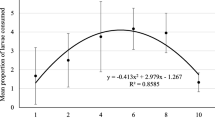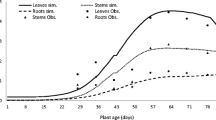Abstract
The aim of the study was to develop a stage-structured within-patch model describing predator-prey interactions of Cheyletus eruditus (Schrank) and Acarus siro L. on stored grain. Parameterisation of the model was done using data from the literature. Due to considerable variance in these data, statistical methods were used to extrapolate the parameters. The results of the simulations were compared with the experimental control of A. siro by C. eruditus on wheat. The results indicated that all life-history studies of A. siro yielded overestimated parameters leading to an unnaturally rapid population growth of A. siro on grain. The main reason seems to be the use of high quality food (wheat germs), which considerably increased fecundity. A new model with reduced fecundity was found to correspond well with the observed dynamics in a granary. The model of C. eruditus, including parameters from different sources, produced dynamics quite similar to the observed one. A simulation of biological control under laboratory conditions, on 45 g of wheat, showed that C. eruditus is able to control A. siro within the observed period. In contrast, simulation of the control in a granary showed a marked difference in comparison with the observed dynamics. The discrepancy is attributed to the effects of spatial factors, such as immigration. The predator-prey model developed here appears to be valid for the prediction of the local (within-patch) population dynamics of A. siro and C. eruditus on wheat grain at 20 °C and 80% RH.





Similar content being viewed by others
Notes
Densities in this paper include only mobile stages of mites in order to be consistent with data from the literature.
References
Barker, PS (1991) Bionomics of Cheyletus eruditus (Schrank) (Acarina: Cheyletidae) a predator of Lepidoglyphus destructor at three constant temperatures. Can J Zool 69:2321–2325
Berreen JM (1974) The development and validation of a simple model for population growth in the grain mite, Acarus siro L. J Stored Prod Res 10:147–154
Berreen JM (1976) An analysis of feeding in Cheyletus eruditus, a predator of storage mite. Ann Appl Biol 82:190–192
Berreen JM (1984) The functional response of Cheyletus eruditus (Schrank) to changes in the density of its prey Acarus siro L. In: Griffiths DA, Bowman CE (eds) Acarology VI, vol 2. Ellis Horwood, Chichester, pp 980–986
Berreen JM, Metwally ASM (1984) Reproductive rates in Cheyletus eruditus (Schrank), In: Griffiths DA, Bowman CE (eds) Acarology VI, vol 1, Ellis Horwood, Chichester, pp 512–518
Boczek J (1957) Flour mite (T. farinae), morphology, biology and ecology, harmfulness and control (in Polish). Rocz Nauk Rolniczych 75A:560–644
Boczek J (1959) Biology of the predatory mite (Cheyletus eruditus) (in Polish). Prace Nauk Inst Ochr Roslin 1:175–230
Boczek JH, Davis R (1985) Effects of alternating temperatures on Acarus siro L. (Acari: Acaridae). Exp Appl Acarol 1:213–217
Brown GA, Davis R (1969) Effects of introduced irradiated male grain mites on population development. J Econ Entomol 62:767–771
Buffoni G, Di Cola G, Baumgartner J, Maurer V (1997) The local dynamics of acarine predator-prey (Cheyletus eruditus - Dermanyssus gallinae) populations: identification of a lumped parameter model. Mitt Schweiz Entomol Ges 70:345–359
Cunnington AM (1976) The effect of physical conditions on the development and increase of some important storage mites. Ann Appl Biol 82:175–178
Cunnington AM (1985) Factors affecting oviposition and fecundity in the grain mite Acarus siro L. (Acarina: Acaridae), especially temperature and relative humidity. Exp Appl Acarol 1:327–344
Cusack PD, Evans GO, Brennan PA (1975) A survey of the mites of stored grain products in the Republic of Ireland. Sci Proc R Dublin Soc Ser B3(20):273–329
Dabrowski ZT (1968) The sensitivity of the developmental stages of flour mite (Acarus siro L.) to gamma radiation. Rocz Nauk Rolnicz 93(Ser A4):613–622 (In Polish)
Deighton, JM, Pascoe R (1976) The use of pirimiphos-methyl to control mites in stored grain. Ann Appl Biol 82:197–201
Emekci M, Toros S (1989) An investigation on the development of Acarus siro L. (Acarina, Acaridae) under different temperatures, and relative humidities (in Turkish). Türk Entomol Derg 13(4):217–228
Emekci M, Toros S (1994) Studies on the biology of Cheyletus eruditus (Schrank) (Acari: Cheyletidae) under laboratory conditions (in Turkish). In: Turkiye III. Biyolojik Mucadele Kongresi Bildirileeri, 25–28 October 1994, Bitki Koruma Bolumu, Ege Universitesi Basimevi, Bornova, Turkey, pp 529–537
Ewing HE (1912) The life-history and habits of Cheyletus seminivorus Packard. J Econ Entomol 5:416–420
Fejt R, Žďárková E (2001) Bionomics of Acarus siro (Acarina: Acaridae) on oilseeds. Plant Prot Sci 37(3):110–113
Hannon B, Ruth M (1997) Modelling dynamic biological systems. Springer, Berlin Heidelberg New York
Hughes AM (1976) The mites of stored food and houses. Tech Bull Minist Agric Lond 9:1–458
Ignatowicz S (1986) Sex ratio in the acarid mites (Acarida: Acaroidea). Rocz Nauk Rolniczych 16(1):101–110
Ignatowicz S (1987) Sex ratio in the flour mite, Acarus siro L. (Acarina, Acaridae). Pol Pismo Entomol 57:775–781
Janssen A, Sabelis MW (1992) Phytoseiid life-histories, local predator-prey dynamics, and strategies for control of tetranychid mites. Exp Appl Acarol 14:233–250
Kawamoto H, Sinha RN, Muir WE, Woods SM (1991) Simulation model of Acarus siro (Acari: Acaridae) in stored wheat. Environ Entomol 20:1381–1386
Nachman G (1991) An acarine predator-prey metapopulation system inhabiting greenhouse cucumbers. Biol J Linn Soc 42:285–303
Norris JD (1958) Observations on the control of mite infestations in stored wheat by Cheyletus spp. (Acarina, Cheyletidae). Ann Appl Biol 46(3):411–422
Pulpán J, Verner PH (1959) The mites of the stored grain and their control (Acari) (in Czech). Boh Cent A1 169–292
Pulpán J, Verner PH (1965) Control of tyroglyphoid mites in stored grain by the predatory mite Cheyletus eruditus (Schrank). Can J Zool 43:417–432
Selhorst T, Sondgerath D, Weigand S (1991) A model describing the predator-prey interaction between Scolothrips longicornis and Tetranychus cinnabarinus based upon the Leslie theory. Ecol Model 59:123–138
Sinha RN (1964) Mites of stored grain in western Canada. Proc Entomol Soc Man 20:19–23
Solomon ME (1946) Tyroglyphid mites in stored products. Nature and amount of damage to wheat. Ann Appl Biol 33:280–289
Solomon ME (1962) Ecology of the flour mite, Acarus siro (=Tyroglyphus farinae DeG.). Ann Appl Biol 50:178–184
Solomon ME (1967) Experiments on predatory-prey interactions of storage mites. Acarologia 11:484–503
Solomon ME (1969) Establishment, growth and decline of populations of the grain mite Acarus siro L. on a handful of wheat. In: Proceedings of the 2nd International Congress of Acarology, July 1967, Sutton Bonington, Akadémiai Kiado, Budapest, pp 255–260
Wilkin DR (1973) Resistance to lindane in Acarus siro from an English cheese store. J Stored Prod Res 9:101–104
Wilkin DR (1975) The effects of mechanical handling and the admixture of acaricides on mites in farm-stored barley. J Stored Prod Res 11: 87–95
Žďárková E (1967) Stored food mites in Czechoslovakia. J Stored Prod Res 3:155–175
Žďárková E (1994) The effectiveness of organophosphate acaricides on stored product mites interacting in biological control. Exp Appl Acarol 18:747–751
Žďárková E (1998a) Mite fauna of stored grain in the Czech Republic. Plant Prot Sci 34(2):49–52
Žďárková E (1998b) Biological control of storage mites by Cheyletus eruditus. Integr Pest Manage Rev 3:111–116
Žďárková E (1998c) The biological protection of the stored grain and seed against mites (in Czech). Metodiky MZe ČR 4:15–29
Žďárková E, Horák E (1985) The effect of blending, scrapping and pelleting on the mortality of mites at manufacturing the feeding mixture. Plant Prot Sci 21(4):275–280
Žďárková E, Horák E (1990) Preventive biological control of stored food mites in empty stores using Cheyletus eruditus (Schrank). Crop Prot 9:378–382
Žďárková E, Horák P (2000) Number of prey necessary for completing development of Cheyletus eruditus (Acarina: Cheyletidae). In: 21st International Congress of Entomology, Abstract. Book I, August 2000, Iquassu Falls, Embrapa Soja, Londrina, p 19
Acknowledgements
We would like to thank A. Honěk, V. Jarošík, V. Stejskal and two anonymous referees for valuable comments. This work was supported by grant no. OC 842.10 (EŽ) and by grant no. 01–01–03 from the Ministry of Agriculture, the Czech Republic (SP).
Author information
Authors and Affiliations
Corresponding author
Rights and permissions
About this article
Cite this article
Pekár, S., Žďárková, E. A model of the biological control of Acarus siro by Cheyletus eruditus (Acari: Acaridae, Cheyletidae) on grain. J Pest Sci 77, 1–10 (2004). https://doi.org/10.1007/s10340-003-0019-0
Received:
Published:
Issue Date:
DOI: https://doi.org/10.1007/s10340-003-0019-0




